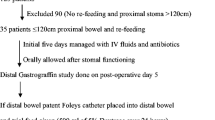Abstract
Purpose
Creation of a temporary loop ileostomy is a standard surgical procedure. This study was undertaken to determine whether dehydration associated with the ileostomy causes renal impairment.
Methods
The prospective data from 107 consecutive patients undergoing temporary loop ileostomy between 2004 and 2009 was evaluated. GFR was calculated at the time of hospital discharge after constructing the ileostomy and at the time of deciding to close the ileostomy.
Results
The average GFR at the time of discharge after constructing the ileostomy was a median of 92.50 (60.75–223.88); at the time of deciding to close the ileostomy, it was 75.25 (4–135.13) ml/min/1.73 m2 (p < 0.001). In 20 patients renal function decreased, with a GFR <60 ml/min/1.73 m2 during the ileostomy period; in six of these 20 patients, the decrease was severe (GFR <30 ml/min/1.73 m2). Underlying diseases, reasons for constructing ileostomies, sex, and time interval to closure did not affect renal function. Patients in whom GFR was decreased at the time of deciding to close the ileostomy presented with significantly more closure-related surgical complications.
Conclusions
Renal impairment is a well-known potential complication of loop ileostomy. To avoid this complication, close control and backup support is recommended in these patients.
Similar content being viewed by others
References
Rondelli F, Reboldi P, Rulli A et al (2009) Loop ileostomy versus loop colostomy for fecal diversion after colorectal or coloanal anastomosis: a meta-analysis. Int J Colorectal Dis 24:479–488
Tilney HS, Parvinder SS, Lovegrove RE et al (2007) Comparison of outcomes following ileostomy versus colostomy for defunctioning colorectal anastomoses. World J Surg 31:1142–1151
Levey AS, Bosch JP, Lewis JB et al (1999) A more accurate method to estimate glomerular filtration rate from serum creatinine: a new prediction equation. Ann Intern Med 130:461–470
National Kidney Foundation (2002) K/DOQI clinical practice guidelines for chronic kidney disease: evaluation, classification, and stratification. Am J Kidney Dis 39(Suppl 1):S1–S266
Nightingale JM, Lennard-Jones JE, Walker ER, Farthing MJ (1992) Oral salt supplements to compensate for jejunostomy losses: comparison of sodium chloride capsules, glucose electrolyte solution, and glucose polymer electrolyte solution. Gut 33(6):759–761
Edwards DP, Leppington-Clark A, Sexton R et al (2001) Stoma-related complications are more frequent after transverse colostomy than loop ileostomy: a prospective randomized clinical trial. Br J Surg 88:360–363
Law WL, Chu KW, Choi HK (2002) Randomized clinical trial comparing loop ileostomy and loop transverse colostomy for faecal diversion following total mesorectal excision. Br J Surg 89:704–708
Rullier E, Le Toux N, Laurent C et al (2001) Loop ileostomy versus loop colostomy for defunctioning low anastomoses during rectal cancer surgery. World J Surg 25:274–277
Tocchi A, Mazzoni G, Miccini M et al (2002) Use of ileostomy and colostomy as temporal derivation in colorectal surgery. G Chir 23:48–52
Baker ML, Williams RN, Nightingale JM (2010) Causes and management of a high output stoma. Colorectal Dis. 2009 Nov 3. (Epub ahead of print)
Bax TW, McNevin MS (2007) The value of diverting loop ileostomy on the high-risk colon and rectal anastomosis. Am J Surg 193:585–588
Phang PT, Hain JM, Perez-Amirez S et al (1999) Techniques and complications of ileostomy takedown. Am J Surg 177:463–466
Thalheimer A, Bueter M, Kortuem M et al (2006) Morbidity of temporary loop ileostomy in patients with colorectal cancer. Dis Colon Rectum 49:1–7
Wexner SD, Taranow DA, Johansen OB et al (1993) Loop ileostomy is a safe option for fecal diversion. Dis Colon Rectum 36:349–354
Feinberg SM, McLeod RS, Cohen Z (1987) Complications of loop ileostomy. Am J Surg 153:102–106
Stevens LA, Coresh J, Greene T et al (2006) Assessing kidney function—measured and estimated glomerular filtration rate. N Engl J Med 354:2473–2483
Rule AD, Larson TS, Bergstralh EJ et al (2004) Using serum creatinine to estimate glomerular filtration rate: accuracy in good health and in chronic kidney disease. Ann Intern Med 141:929–937
Go A, Cherrow G, Fan D et al (2004) Chronic kidney disease and the risks of death, cardiovascular events, and hospitalisation. N Engl J Med 351:1296–1305
Weise WJ, Serrano FA, Fought J, Gennari FJ (2008) Acute electrolyte and acid-base disorders in patients with ileostomies: a case series. Am J Kidn Dis 52(3):494–500
Bakx R, Busch ORC, Bemelman WA et al (2004) Morbidity of temporary loop ileostomies. Dig Surg 21:277–281
Hesp WL, Lubbers EJ, de Boer HH et al (1986) Anastomotic insufficiency in small bowel surgery-incidence and treatment. Langenbecks Arch Surg 368:105–111
Kairaluoma M, Rissanen H, Kultti V et al (2002) Outcome of temporary stomas. A prospective study of temporary intestinal stomas constructed between 1989 and 1996. Dig Surg 19:45–51
Khoo RE, Cohen MM, Chapman GM et al (1994) Loop ileostomy for temporary fecal diversion. Am J Surg 167:519–522
Saha AK, Tapping CR, Foley GT et al (2009) Morbidity and mortality after closure of loop ileostomy. Colorectal Dis 11:866–871
Mathiessen P, Hallböök O, Rutegärd J et al (2007) Defunctioning stomas reduces symptomatic anastomotic leakage after low anterior resection of the rectum for cancer: a randomized multicenter trial. Ann Surg 246:207–214
Dehni N, Schlegel RD, Cunningham C et al (1998) Influence of a defunctioning stoma on leakage rates after low colorectal anastomosis. Br J Surg 85:1114–1117
Author information
Authors and Affiliations
Corresponding author
Rights and permissions
About this article
Cite this article
Beck-Kaltenbach, N., Voigt, K. & Rumstadt, B. Renal impairment caused by temporary loop ileostomy. Int J Colorectal Dis 26, 623–626 (2011). https://doi.org/10.1007/s00384-010-1086-3
Accepted:
Published:
Issue Date:
DOI: https://doi.org/10.1007/s00384-010-1086-3




